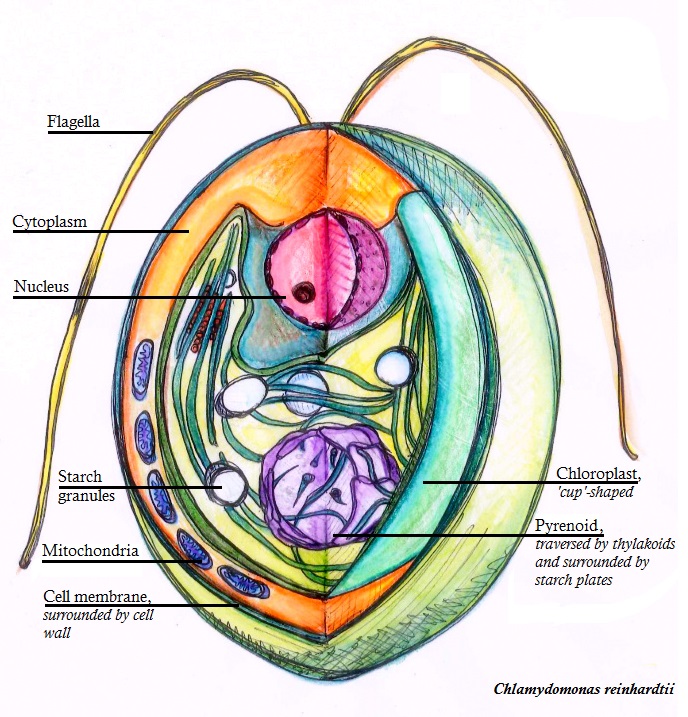|
D66 Strain Of Chlamydomonas Reinhardtii
The D66 strain of '' Chlamydomonas reinhardtii'', a single-celled green alga, is a cell-wall-deficient strain of algae that exhibits normal photosynthetic characteristics, but requires ammonia as a source of nitrogen for growth. This strain of green algae is becoming an increasingly popular research organism due to its potential to be used as a source of biofuels. The D66 strain's potential to produce clean and renewable biofuel has also made it an increasingly important topic in the field of conservation biology. Background The D66 strain of ''Chlamydomonas reinhardtii'' has been genetically engineered with no cell wall in order to increase the strain's growth and photosynthesis rates. The technique of genetically engineering green algae to increase oil production for biofuels is becoming increasingly more prevalent around the United States. With factors such as high petroleum prices and growing environmental protection concerns, the need for clean and renewable energy sources i ... [...More Info...] [...Related Items...] OR: [Wikipedia] [Google] [Baidu] |
Chlamydomonas Reinhardtii
''Chlamydomonas reinhardtii'' is a single-cell green alga about 10 micrometres in diameter that swims with two flagella. It has a cell wall made of hydroxyproline-rich glycoproteins, a large cup-shaped chloroplast, a large pyrenoid, and an eyespot that senses light. '' Chlamydomonas'' species are widely distributed worldwide in soil and fresh water. ''Chlamydomonas reinhardtii'' is an especially well studied biological model organism, partly due to its ease of culturing and the ability to manipulate its genetics. When illuminated, ''C. reinhardtii'' can grow photoautotrophically, but it can also grow in the dark if supplied with organic carbon. Commercially, ''C. reinhardtii'' is of interest for producing biopharmaceuticals and biofuel, as well being a valuable research tool in making hydrogen. History The ''C. reinhardtii'' wild-type laboratory strain c137 (mt+) originates from an isolate collected near Amherst, Massachusetts, in 1945 by Gilbert M. Smith. The species' n ... [...More Info...] [...Related Items...] OR: [Wikipedia] [Google] [Baidu] |
Green Algae
The green algae (singular: green alga) are a group consisting of the Prasinodermophyta and its unnamed sister which contains the Chlorophyta and Charophyta/Streptophyta. The land plants (Embryophytes) have emerged deep in the Charophyte alga as sister of the Zygnematophyceae. Since the realization that the Embryophytes emerged within the green algae, some authors are starting to properly include them. The completed clade that includes both green algae and embryophytes is monophyletic and is referred to as the clade Viridiplantae and as the kingdom Plantae. The green algae include unicellular and colonial flagellates, most with two flagella per cell, as well as various colonial, coccoid and filamentous forms, and macroscopic, multicellular seaweeds. There are about 22,000 species of green algae. Many species live most of their lives as single cells, while other species form coenobia (colonies), long filaments, or highly differentiated macroscopic seaweeds. A few other organi ... [...More Info...] [...Related Items...] OR: [Wikipedia] [Google] [Baidu] |
Conservation Biology
Conservation biology is the study of the conservation of nature and of Earth's biodiversity with the aim of protecting species, their habitats, and ecosystems from excessive rates of extinction and the erosion of biotic interactions. It is an interdisciplinary subject drawing on natural and social sciences, and the practice of natural resource management. The conservation ethic is based on the findings of conservation biology. Origins The term conservation biology and its conception as a new field originated with the convening of "The First International Conference on Research in Conservation Biology" held at the University of California, San Diego in La Jolla, California, in 1978 led by American biologists Bruce A. Wilcox and Michael E. Soulé with a group of leading university and zoo researchers and conservationists including Kurt Benirschke, Sir Otto Frankel, Thomas Lovejoy, and Jared Diamond. The meeting was prompted due to concern over tropical deforestation, disappearin ... [...More Info...] [...Related Items...] OR: [Wikipedia] [Google] [Baidu] |
Louisiana State University
Louisiana State University (officially Louisiana State University and Agricultural and Mechanical College, commonly referred to as LSU) is a public land-grant research university in Baton Rouge, Louisiana. The university was founded in 1860 near Pineville, Louisiana, under the name Louisiana State Seminary of Learning & Military Academy. The current LSU main campus was dedicated in 1926, consists of more than 250 buildings constructed in the style of Italian Renaissance architect Andrea Palladio, and the main campus historic district occupies a plateau on the banks of the Mississippi River. LSU is the flagship school of the state of Louisiana, as well as the flagship institution of the Louisiana State University System, and is the most comprehensive university in Louisiana. In 2021, the university enrolled over 28,000 undergraduate and more than 4,500 graduate students in 14 schools and colleges. Several of LSU's graduate schools, such as the E. J. Ourso College of Business ... [...More Info...] [...Related Items...] OR: [Wikipedia] [Google] [Baidu] |
University Of Arkansas
The University of Arkansas (U of A, UArk, or UA) is a public land-grant research university in Fayetteville, Arkansas. It is the flagship campus of the University of Arkansas System and the largest university in the state. Founded as Arkansas Industrial University in 1871, classes were first held on January 22, 1872, with its present name adopted in 1899. It is noted for its strong programs in architecture, agriculture (particularly animal science and poultry science), communication disorders, creative writing, history, law (particularly agricultural law), and Middle Eastern studies, as well as for its business school, of which the supply chain management program was ranked the best in North America by Gartner in July 2020. In a 2021 study compiled by DegreeChoices and published by Forbes, the University of Arkansas ranked 13th among universities with the most graduates working at top Fortune 500 companies. The university campus consists of 378 buildings spread across of land ... [...More Info...] [...Related Items...] OR: [Wikipedia] [Google] [Baidu] |
Arizona State University
Arizona State University (Arizona State or ASU) is a public research university in the Phoenix metropolitan area. Founded in 1885 by the 13th Arizona Territorial Legislature, ASU is one of the largest public universities by enrollment in the U.S. One of three universities governed by the Arizona Board of Regents, ASU is a member of the Universities Research Association and classified among "R1: Doctoral Universities – Very High Research Activity". ASU has nearly 150,000 students attending classes, with more than 38,000 students attending online, and 90,000 undergraduates and nearly 20,000 postgraduates across its five campuses and four regional learning centers throughout Arizona. ASU offers 350 degree options from its 17 colleges and more than 170 cross-discipline centers and institutes for undergraduates students, as well as more than 400 graduate degree and certificate programs. The Arizona State Sun Devils compete in 26 varsity-level sports in the NCAA Division I Pac ... [...More Info...] [...Related Items...] OR: [Wikipedia] [Google] [Baidu] |
Algae Fuels
Algae fuel, algal biofuel, or algal oil is an alternative to liquid fossil fuels that uses algae as its source of energy-rich oils. Also, algae fuels are an alternative to commonly known biofuel sources, such as corn and sugarcane. When made from seaweed (macroalgae) it can be known as seaweed fuel or seaweed oil. It is also carbon negative unless the dead plant matter is burned, as the energy (stored as hydrogen gas) is produced by solar photosynthesis and comes from the sun. The emissions from burning the hydrogen make up only water and air. Several companies and government agencies are funding efforts to reduce capital and operating costs and make algae fuel production commercially viable. Like fossil fuel, algae fuel releases when burnt, but unlike fossil fuel, algae fuel and other biofuels only release recently removed from the atmosphere via photosynthesis as the algae or plant grew. The energy crisis and the world food crisis have ignited interest in algaculture (farmi ... [...More Info...] [...Related Items...] OR: [Wikipedia] [Google] [Baidu] |
Conservation Biology
Conservation biology is the study of the conservation of nature and of Earth's biodiversity with the aim of protecting species, their habitats, and ecosystems from excessive rates of extinction and the erosion of biotic interactions. It is an interdisciplinary subject drawing on natural and social sciences, and the practice of natural resource management. The conservation ethic is based on the findings of conservation biology. Origins The term conservation biology and its conception as a new field originated with the convening of "The First International Conference on Research in Conservation Biology" held at the University of California, San Diego in La Jolla, California, in 1978 led by American biologists Bruce A. Wilcox and Michael E. Soulé with a group of leading university and zoo researchers and conservationists including Kurt Benirschke, Sir Otto Frankel, Thomas Lovejoy, and Jared Diamond. The meeting was prompted due to concern over tropical deforestation, disappearin ... [...More Info...] [...Related Items...] OR: [Wikipedia] [Google] [Baidu] |







